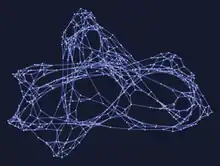Wolfram Physics Project
The Wolfram Physics Project is a project launched by computer scientist and physicist Stephen Wolfram to find the fundamental theory of physics.[1][2] The project builds on Wolfram's previous research into computational systems, as explored in his book, A New Kind of Science. The project was launched in April 2020[3][4][5] with the main contributors being Stephen Wolfram, Jonathan Gorard and Max Piskunov.[6] A book, A Project to Find the Fundamental Theory of Physics, was published about the project in June 2020.[7] The project has been criticized for seeking publicity before having any testable predictions.[8][9][10]
Project description

The project is built around exploring simple computational systems that create complex networks of causal relationships. The formalism of the model is that of a discrete spacetime in which space is represented by a hypergraph obeying the rules of an abstract rewriting system. The passage of time is then modeled by the update steps of the rules of the rewriting system. This opens the door to a systematic computational search through the rules that are able to generate a network with features that mirror the laws of physics, thus leading to the project's goal of trying to find "the rule of the universe".[4][11] The Wolfram model is said to reproduce key features of both quantum mechanics[12] as well as special and general relativity.[13] In order for the model to present these features, it must exhibit the Church-Rosser property (or "causal invariance" as Wolfram terms it). Most of the example models come from a rewriting system on ordered graphs; some concepts are illustrated by examples pertaining to string rewriting systems. Many of the computational phenomena obtained in these systems bear analogy to Wolfram's previous investigations into cellular automata. This newly introduced ordered-graph system lends itself to geometrical interpretation in a way that cellular automata did not, and it is mainly these geometrical interpretations that provide an entry point into analogy with physical law.[14]
The Wolfram Physics Project is being presented to the public as an open project, where all the technical documentation as well as software tools and live recordings of working sessions on the project are freely accessible to the public.[5] In a controversial move, Wolfram did not seek peer review prior to publishing his work.[9] Stephen Wolfram and Jonathan Gorard have posted preprints on the topic to the arXiv; Gorard's was submitted to the journal Complex Systems, which was founded by Wolfram in 1987.[13][15]
Reception
While Stephen Wolfram claims the project has been a success with scientists and others engaging with the project through the livestreamed content,[16] other prominent physicists have leveled criticism at the project as not "even science at this point."[8][9][10]
Criticisms of the project center around the apparent non-quantitative aspect of the theory, with noted quantum computing scientist Scott Aaronson stating: "It's this sort of infinitely flexible philosophy where, regardless of what anyone said was true about physics, they could then assert, 'Oh, yeah, you could graft something like that onto our model'".[10]
Wolfram's decision not to seek traditional peer-review was also a point of contention in the physics community.[9][10] Physicist Sean Carroll commented that "it would be more effective to write short papers addressing specific problems with this kind of approach rather than proclaiming a breakthrough without much vetting."[10]
References
- Yirka, Bob (15 April 2020). "The Wolfram Physics Project hopes to find fundamental theory of physics". Phys.org. Retrieved 1 June 2020.
- Linder, Courtney (16 April 2020). "Legendary Physicist Stephen Wolfram Is Modeling Our Universe, and He Needs Your Help". Popular Mechanics. Retrieved 1 June 2020.
- "Stephen Wolfram Invites You to Solve Physics". Wired. ISSN 1059-1028. Retrieved 2020-05-26.
- "Stephen Wolfram's hypergraph project aims for a fundamental theory of physics". Science News. 2020-04-14. Retrieved 2020-05-26.
- "A new kind of physics? Stephen Wolfram has a radical plan to build the universe from dots and lines". the conversation. Retrieved 2020-05-26.
- "Stephen Wolfram's project announcement". Stephen Wolfram's blog. 2020-04-14. Retrieved 2020-05-26.
- "A Project to Find the Fundamental Theory of Physics: Wolfram Media". WolframMedia. Retrieved 1 August 2020.
- Ethan Siegel & Starts With A Bang (May 13, 2020). "3 Simple Reasons Why Wolfram's New 'Fundamental Theory' Is Not Yet Science". Forbes.CS1 maint: uses authors parameter (link)
- "The trouble with Stephen Wolfram's new "fundamental theory of physics"". Gizmodo. 2020-04-22. Retrieved 2020-05-26.
- "Physicists criticize Stephen Wolfram's "theory of everything"". Scientific American. 2020-05-06. Retrieved 2020-05-26.
- "The Wolfram Physics Project: specific models of the universe". The Wolfram Physics Project. Retrieved 2020-05-26.
- "Some quantum mechanical properties of the Wolfram model" (PDF). The Wolfram Physics Project. Retrieved 2020-05-26.
- Gorard, Jonathan (2020-04-28). "Some relativistic and gravitational properties of the Wolfram model". arXiv:2004.14810 [cs.DM].
- "Relation of the model to physics". Retrieved 22 May 2020.
- Wolfram, Stephen (2020-04-15). "A class of models with the potential to represent fundamental physics". arXiv:2004.08210 [cs.DM].
- "The Wolfram Physics Project: The First Two Weeks". Stephen Wolfram's blog. 2020-04-29. Retrieved 2020-05-26.
